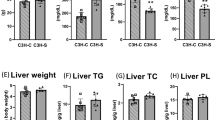Abstract
The role of plasma phospholipid transfer protein (PLTP) in lipoprotein metabolism is poorly understood. In vitro studies suggest that PLTP influences HDL size and composition and transfers phospholipids among lipoproteins. To provide an in vivo model for studies of PLTP physiology, transgenic mice that express human PLTP were generated. Human PLTP transcripts were detected in total RNA from adipose tissue, lung, heart, and spleen of the two distinct lines (A and C) of transgenic mice. Despite minimal expression of human PLTP in the liver of these transgenic mice and similar plasma phospholipid transfer activity in transgenic and non-transgenic mice (19.1±3.1 vs 18.9±2.7 μmol/ml/h), differences in lipoprotein levels were observed between transgenic and control mice receiving the same chow diet. Male transgenic mice of line C had significantly higher HDL cholesterol than control mice (76.4±4.6 vs 71.9±7.0 mg/dl, p<0.05) and the male transgenic mice of lines A and C had a significantly lower non-HDL cholesterol (15.1±4.1 and 15.6 ±4.7 vs 20.9±5.5 mg/dl,P<0.01 andP<0.02) and a significantly higher HDL cholesterol/non-HDL cholesterol ratio than the control mice (5.3±1.3 and 5.5±2.2 vs 3.9 ±1.9 mg/dl,P<0.01 andP<0.02). Female mice from transgenic line C had higher HDL cholesterol than control mice (64.6±4.8 vs 57.4±5.1 mg/dl,P<0.01) while female mice from line A tended to have higher HDL cholesterol/non-HDL cholesterol ratio than control mice (5.5±3.7 vs 3.8±1.4). These observations suggest that expression of PLTP in peripheral tissues play an important role in lipoprotein metabolism. Expression of human PLTP produced a more favorable lipoprotein profile and thus, enhanced expression of PLTP could potentially retard atherosclerosis.
Similar content being viewed by others
References
Tollefson JH, Ravnik S, Albers JJ. Isolation and characterization of a phospholipid transfer protein (LTP-II) from human plasma. J Lipid Res 1988; 29:1593.
Tall AR. Plasma cholesteryl ester transfer protein. J Lipid Res 1993;34: 1255.
Cheung MC, Wolfbauer G, Albers JJ. Plasma phospholipid mass transfer rate: relationship to plasma phospholipid and cholesteryl ester transfer activities and lipid parameters. Biochim Biophys Acta 1996; 1303:103.
Tu A-Y, Nishida HI, Nishida T. High density lipoprotein conversion mediated by human phospholipid transfer protein. J Biol Chem 1993; 268: 23098.
Jauhiainen M, Metso J, Pahlman R, Blomqvist S, van Tol A, Ehnholm C Human plasma phospholipid transfer protein causes high density lipoprotein conversion. J Biol Chem 1993; 268: 2032.
Albers JJ, Wolfbauer G, Cheung MC, Day JR, Ching AFT, Lok S, Tu A-Y. Funotional expression of human and mouse plasma phospholipid transfer protein: effect of recombinant and plasma PLTP on HDL subspecies. Biochim Biophys Acta 1995; 1258: 27.
von Eckardstein A, Jauhiainen M, Huang Y, Metso J Langer C, Pussenen P, Wu S, Ehnholm C, Assmann G. Phospholipid transfer protein mediated conversion of high density lipoproteins generates pre-beta-HDL. Biochim Biophys Acta 1996; 1301: 255.
Kostner GM, Oettl K, Jauhiainen M, Ehnholm C, Esterbauer H, Dieplinger H. Human plasma phospholipid transfer protein accelerates exchange/transfer of alpha-tocopherol between lipoproteins and cells. Biochem J 1995; 305: 659.
Hailman E, Albers JJ, Wolfbauer G, Tu A-Y, Wright SD. Neutralization and transfer of lipopolysaccharide by phospholipid transfer protein. J Biol Chem 1996; 271: 12172.
Day JR, Albers JJ, Lofton-Day CE, Gilbert TL, Ching AFT. Grant FJ, O'Hara PJ, Marcovina SM, Adolphson JL. Complete cDNA encoding human phospholipid transfer protein from human endothelial cells. J Biol Chem 1994; 269: 9388.
Tu A-Y, Deeb SS, Iwasaki L, Day JR, Albers JJ. Organization of human phospholipid transfer protein gene. Biochem Biophys Res Commun 1995; 207: 552.
Tu A-Y, Chen H, Johnson KA, Paigen B, Albers JJ, Characterization of the mouse gene encoding phospholipid transfer protein. Gene 1997; in press.
Whitmore TE, Day JR, Albers JJ. Localization of the human phospholipid transfer protein gene to chromosome 20q12-q13.1. Genomics 1995; 28: 599.
LeBoeuf RC, Caldwell M, Tu A-Y, Albers JJ. Phospholipid transfer protein maps to distal mouse chromosome 2. Genomics 1996; 34: 259.
Tu A-Y, Wolfbauer G, Albers JJ. Functional characterization of the promoter region of the human phospholipid transfer protein gene. Biochem Biophys Res Commun 1995; 217: 705.
Warnick GR. Enzymatic methods for quantification of lipoproteins. In: Albers JJ, Segrest JP, eds. Methods in enzymology, vol. 129, Plasma lipoproteins. Part B Orlando: Academic Press Inc. 1986: 101–123.
Jiang X-C, Bruce C. Regulation of murine plasma phospholipid transfer protein activity and mRNA levels by lipopolysaccharide and high cholesterol diet. J Biol Chem 1995; 270: 17133.
Linton MF, Fiarese RV Jr, Chiesa G, Grass DS, Chin P, Hammer RE, Hobbs HH, Young SG. Transgenic mice expressing high plasma concentrations of human apolipoprotein B100 and lipoprotein(a). J Clin Invest 1993; 92: 3029.
McCormick SPA, Ng JK, Veniant M, Boren J, Pierotti V, Filynn LM, Grass DS, Connolly A, Young SG. Transgenic mice that overexpress mouse apolipoprotein B. Evidence that the DNA sequences controlling intestinal expression of the apolipoprotein B gene are distant from the structural gene. J Biol Chem 1996; 271:11963.
Callow MJ, Stoltzfus LJ, Lawn RM, Rubin EM. Expression of human apolipoprotein B and assembly of lipoprotein(a) in transgenic mice. Proc Natl Acad Sci USA 1994; 91:2130.
Jiang XC, Moulin P, Quinet E, Goldberg IJ, Yacoub LK, Agellon LB, Compton D, Schnitzer-Polokoff R, Tall AR, Mammalian adipose tissue and muscle are major sources of lipid transfer protein mRNA. J Biol Chem 1991; 266:4631.
Enerback S, Gimble JM. Lipoprotein lipase gene expression: physiological regulators at the transcriptional and post-transcriptional level. Biochim Biophys Acta 1993; 1169: 107.
Tall AR, Krumholz S, Olivecrona T, Deckelbaum RJ. Plasma phospholipid transfer protein enhances transfer and exchange of phospholipids between very low density lipoproteins and high density lipoproteins during lipolysis. J Lipid Res 1985; 26: 842.
Author information
Authors and Affiliations
Rights and permissions
About this article
Cite this article
Albers, J.J., Tu, A.Y., Paigen, B. et al. Transgenic mice expressing human phospholipid transfer protein have increased HDL/non-HDL cholesterol ratio. Int J Clin Lab Res 26, 262–267 (1996). https://doi.org/10.1007/BF02602960
Received:
Accepted:
Issue Date:
DOI: https://doi.org/10.1007/BF02602960




